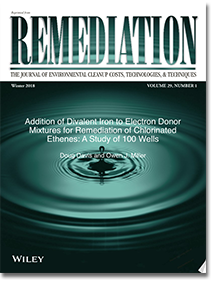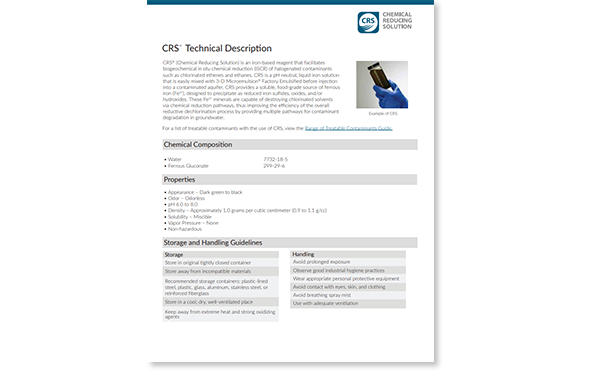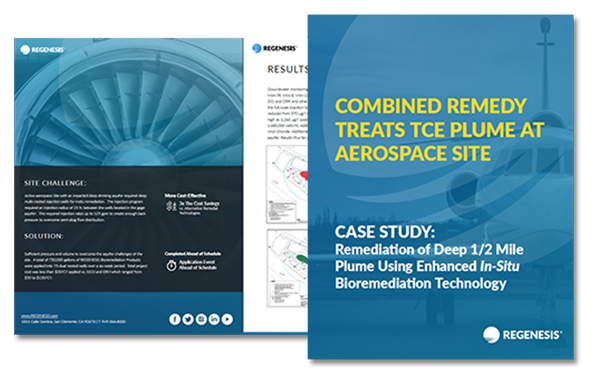

A Liquid Iron-Based Reagent for the Enhanced Biogeochemical In Situ Chemical Reduction (ISCR) of Chlorinated Contaminants
- Facilitates biogeochemical in situ chemical reduction (ISCR) of chlorinated contaminants
- Provides multiple pathways, both abiotic and biotic, for contaminant degradation in groundwater
- Contains a form of liquid iron which provides better distribution than can be achieved by directly injecting a solid iron material
- Seamless integration with anaerobic bioremediation
- Easy to apply with the electron donor 3-D Microemulsion
RESOURCES
Innovative Enhanced Reductive Dechlorination Design Cleans Up Large, Fast Moving Plume
How it Works
CRS® (Chemical Reducing Solution) is an iron-based amendment for in situ chemical reduction (ISCR) of halogenated hydrocarbon contaminants such as chlorinated ethenes and ethanes. CRS is a pH neutral, liquid iron solution that is easily mixed with 3-D Microemulsion Factory Emulsified before injection into contaminated groundwater. CRS is a soluble, food-grade source of ferrous iron (Fe2+), designed to precipitate reduced iron sulfides, oxides, and/or hydroxides as shown in equation 1. These Fe2+ minerals are capable of destroying chlorinated solvents via chemical reduction pathways, thus improving the efficiency of the overall reductive dechlorination process by providing multiple pathways for contaminant degradation in groundwater.
- Equation 1.
1 CRS (Fe2+) + anaerobic groundwater → FeS + FeS2 + FexOy + FexOy(OH)z
2 Reduced iron minerals + PCE → ethene + ethane + iron chlorides
The incorporation of iron as metallic particles or ferrous salts (Fe2+) can enhance chlorinated contaminant remediation by enabling various chemical reduction pathways. The overall combination of biological and chemical processes are referred to as “biogeochemical” reduction of contaminants. Biogeochemical reduction utilizes the biologically-generated reducing environment to create reduced iron precipitates that then go on to chemically reduce chlorinated solvents.
CRS is used in conjunction with 3-D Microemulsion to provide the necessary iron to activate abiotic chemical reduction (including the β-elimination pathway) of chlorinated organic groundwater contaminants like perchloroethene (PCE), trichloroethene (TCE), dichloroethene (DCE), and vinyl chloride (VC). The end products of these biogeochemical reductions are ethene and ethane.
Target Contaminants:
Chlorinated Solvents
- Tetrachloroethylene (PCE)
- Trichloroethene (TCE)
- cis-1,2 Dichloroethene (DCE)
- Vinyl chloride (VC)
- Tetrachloroethane
- Trichloroethane (TCA)
- Dichloroethane (DCA)
- Carbon tetrachloride
- Chloroethane
For a complete listing of treatable contaminants please visit our Range of Treatable Contaminants Page.
Typical Soil and Groundwater Remediation Application Methods:
Application/Injection:
- Permanent injection wells
- Direct-push injection points
Research Article: Addition of Divalent Iron to Electron Donor Mixtures
 The objective of this study is to asses the effects of adding soluble divalent iron (DVI) to emulsified electron donor mixtures to promote the biogeochemical destruction of TCE, PCE, cis-1,2 DCE, and VC in groundwater. 24 projects sites were studied, comprising 100 performance monitoring wells across the US. Wells that received the DVI showed increased dechlorination rates, improved contaminant reduction, and limited daughter product formation relative to the wells that did not receive the DVI.
The objective of this study is to asses the effects of adding soluble divalent iron (DVI) to emulsified electron donor mixtures to promote the biogeochemical destruction of TCE, PCE, cis-1,2 DCE, and VC in groundwater. 24 projects sites were studied, comprising 100 performance monitoring wells across the US. Wells that received the DVI showed increased dechlorination rates, improved contaminant reduction, and limited daughter product formation relative to the wells that did not receive the DVI.
Next Steps:
If you currently have a project and need a remediation solution now, visit our Request a Design page.
Have questions or want to explore some ideas? Contact Us to get in touch with a local representative.
Are you planning a remediation project?
Contact Us to explore solutions and options.
FAQs about Chemical Reducing Solution (CRS®)
Chemical Reducing Solution is a liquid iron-based reagent for the enhanced biogeochemical in situ chemical reduction (ISCR) of chlorinated contaminants. CRS is a pH neutral, liquid iron solution that is injected into contaminated groundwater to treat halogenated hydrocarbon contaminants such as chlorinated ethenes and ethanes.
CRS is a soluble, food-grade source of ferrous iron (Fe2+), designed to precipitate reduced iron sulfides, oxides, and/or hydroxides. These Fe2+ minerals are capable of destroying chlorinated solvents via chemical reduction pathways, thus improving the efficiency of the overall reductive dechlorination process by providing multiple pathways for contaminant degradation in groundwater.
Chemical Reducing Solution is right for your project if you are treating halogenated hydrocarbon contaminants such as chlorinated ethenes and ethanes and your treatment requires multiple pathways, both abiotic and biotic, for contaminant degradation in groundwater.


 Americas
Americas Europe
Europe Français
Français Deutsch
Deutsch Italiano
Italiano Español
Español





